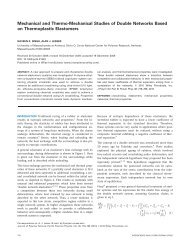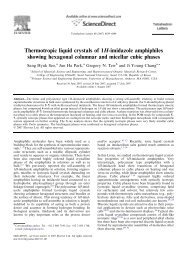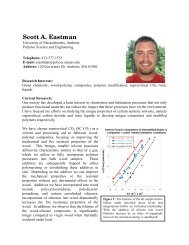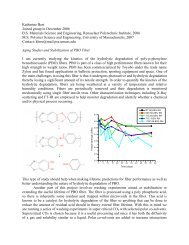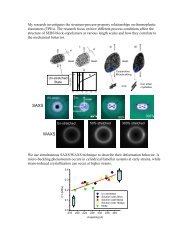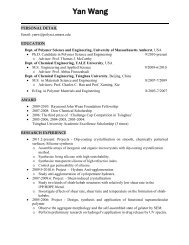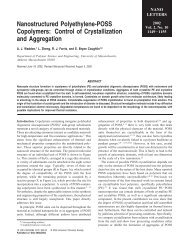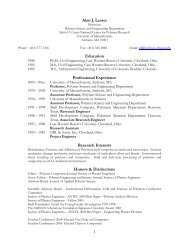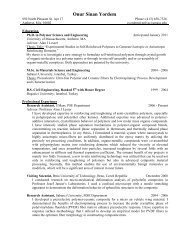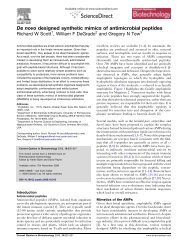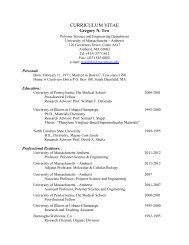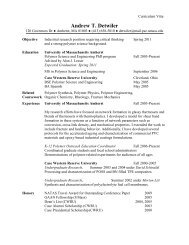Synthesis of hydrogels via ring-opening metathesis polymerization
Synthesis of hydrogels via ring-opening metathesis polymerization
Synthesis of hydrogels via ring-opening metathesis polymerization
Create successful ePaper yourself
Turn your PDF publications into a flip-book with our unique Google optimized e-Paper software.
Polymer<br />
Chemistry<br />
View Online<br />
Dynamic Article Links C <<br />
Cite this: Polym. Chem., 2011, 2, 114<br />
www.rsc.org/polymers<br />
<strong>Synthesis</strong> <strong>of</strong> <strong>hydrogels</strong> <strong>via</strong> <strong>ring</strong>-<strong>opening</strong> <strong>metathesis</strong> <strong>polymerization</strong>: factors<br />
affecting gelation<br />
Ahmad E. Madkour, Joshua M. Grolman and Gregory N. Tew*<br />
PAPER<br />
Downloaded on 05 May 2011<br />
Published on 01 November 2010 on http://pubs.rsc.org | doi:10.1039/C0PY00151A<br />
Received 11th May 2010, Accepted 21st August 2010<br />
DOI: 10.1039/c0py00151a<br />
Ring-<strong>opening</strong> <strong>metathesis</strong> <strong>polymerization</strong> (ROMP) was used to synthesize <strong>hydrogels</strong> <strong>via</strong><br />
co<strong>polymerization</strong> <strong>of</strong> a diamine monomer 3 and a novel cross-linker 5 using Grubbs’ third generation<br />
catalyst as initiator. Reactions were performed at two different monomer concentrations and at various<br />
initial molar ratios <strong>of</strong> cross-linker to initiator. At low monomer concentration, gelation occurred at<br />
initial cross-linker to initiator ratios <strong>of</strong> 1.5 and greater, which decreased to values <strong>of</strong> 1.05 and greater<br />
when increasing the monomer concentration. This result is in agreement with the Flory–Stockmayer<br />
theory. The gel yield and swelling properties were also found to be dependent on the cross-linker to<br />
initiator molar ratios. GPC data <strong>of</strong> the sol fractions showed quantitative consumption <strong>of</strong> both the<br />
monomer and the cross-linker. The molecular weight <strong>of</strong> the sol fraction was independent <strong>of</strong> the initiator<br />
concentration at constant cross-linker concentration <strong>of</strong> 2.5 mol%. Gels were found to swell up to<br />
72 times their weight in 0.9% NaCl solution.<br />
Introduction<br />
reversible addition fragmentation chain transfer (RAFT), 8<br />
and nitroxide-mediated <strong>polymerization</strong>. 9,10 These approaches<br />
Hydrogels and polyelectrolyte networks have received much<br />
afford networks with more homogeneous structures because <strong>of</strong><br />
attention because <strong>of</strong> their numerous applications in fields such as<br />
their inverse reaction kinetics (fast initiation and slow chain<br />
superabsorbent materials, s<strong>of</strong>t contact lenses, tissue enginee<strong>ring</strong>,<br />
growth). 10,11 Armes and coworkers studied the co<strong>polymerization</strong><br />
controlled drug delivery, and regenerative medicine. 1–3 The most<br />
<strong>of</strong> 2-hydroxypropyl methacrylate with ethylene glycol dimethacrylate<br />
(EGDMA) as a cross-linker under ATRP conditions. 12<br />
common method for prepa<strong>ring</strong> these networks is by the co<strong>polymerization</strong><br />
<strong>of</strong> a hydrophilic or charged monomer with a crosslinker.<br />
4 Free-radical <strong>polymerization</strong> (FRP) has been widely used<br />
Soluble branched copolymer (sol) was obtained when less than<br />
one branching agent (EGDMA) was incorporated per primary<br />
for constructing these networks because <strong>of</strong> its mild experimental<br />
polymer chain. Higher levels <strong>of</strong> EGDMA (1.1 mol per primary<br />
conditions and the wide range <strong>of</strong> monomers that can be used.<br />
chain) led to gelation. Similarly, the co<strong>polymerization</strong> <strong>of</strong> methyl<br />
However, FRP has little control over the primary polymer chain<br />
acrylate and ethylene glycol diacrylate (EGDA) using ATRP led<br />
network structure, which leads to microgel formation and<br />
to gel formation at initial cross-linker to initiator molar ratios<br />
a heterogeneous network structure. 5 This is attributed to slow<br />
([CL] o /[I] o ) equal to or greater than 1.1. 5 This shows that the<br />
initiation, fast chain propagation, and the presence <strong>of</strong> termination<br />
reactions. 5 At the beginning <strong>of</strong> the <strong>polymerization</strong>, indi-<br />
reactions using ATRP closely follow the predictions <strong>of</strong> Flory and<br />
Stockmayer for gelation, which state that gelation occurs when<br />
vidual chains with high molecular weight and a large number <strong>of</strong><br />
the cross-linking index is unity. 13–16<br />
pendant double bonds are formed in a short time. The relatively<br />
In the case <strong>of</strong> branched polymer synthesis using RAFT, several<br />
high dilution <strong>of</strong> chains in solution combined with slow diffusion<br />
studies showed strong de<strong>via</strong>tions from the Flory–Stockmayer<br />
and fast propagation rates leads to rapid intramolecular reactions<br />
between propagating chains and pendant double bonds.<br />
predictions (up to 3.6 cross-linker units per polymer chain<br />
without forming gels). 11,17–19 This may be attributed to a considerable<br />
degree <strong>of</strong> intramolecular cyclization rather than the<br />
This generates various loops and densely cross-linked domains<br />
(microgels). These structural features then lead to the above<br />
desired intermolecular reaction. Intramolecular cyclization can<br />
mentioned heterogeneities.<br />
be suppressed by conducting RAFT co<strong>polymerization</strong> at a relatively<br />
high monomer concentration, similar to that used in<br />
One method to improve the homogeneity <strong>of</strong> the network is to<br />
employ controlled radical <strong>polymerization</strong> (CRP) techniques,<br />
including atom transfer radical <strong>polymerization</strong> (ATRP), 4–7<br />
Department <strong>of</strong> Polymer Science & Enginee<strong>ring</strong>, University <strong>of</strong><br />
Massachusetts, 120 Governors Drive, Amherst, MA, 01003, USA.<br />
E-mail: tew@mail.pse.umass.edu; Fax: +1-413-545-0082<br />
ATRP (i.e. 50% w/w instead <strong>of</strong> 20% w/v). 20 Gelation by this<br />
RAFT formulation more closely conforms to the Flory–Stockmayer<br />
theory.<br />
Ring-<strong>opening</strong> <strong>metathesis</strong> <strong>polymerization</strong> (ROMP) is another<br />
living/controlled <strong>polymerization</strong> method, and thus appeared to<br />
be a promising method to control the gelation process. ROMP<br />
114 | Polym. Chem., 2011, 2, 114–119 This journal is ª The Royal Society <strong>of</strong> Chemistry 2011
View Online<br />
guard column, and a Knauer RI detector. The system was<br />
calibrated against polystyrene standards, with toluene as the flow<br />
marker.<br />
Downloaded on 05 May 2011<br />
Published on 01 November 2010 on http://pubs.rsc.org | doi:10.1039/C0PY00151A<br />
has become a valuable tool for the preparation <strong>of</strong> a broad variety<br />
<strong>of</strong> materials. Among many types <strong>of</strong> ROMP catalyst systems,<br />
ruthenium-based complexes, particularly Grubbs’ 1 st to 3 rd<br />
generation catalysts, are the most successful because they display<br />
high reactivity at room temperature and are relatively stable<br />
under ambient conditions. 21,22 Furthermore, they are tolerant<br />
to functional groups including alcohols, acids and tertiary<br />
amines. 23–25 The synthesis <strong>of</strong> ROMP networks is known, but<br />
mainly for hydrophobic monomers, and has been typically used<br />
to make thermosets. 26,27 To our knowledge, there are only two<br />
previous reports <strong>of</strong> ROMP based hydrophilic networks. Hamilton<br />
and coworkers polymerized norbornene-dicarboxylic acid<br />
anhydride in the presence <strong>of</strong> an alcohol and a diol to obtain gels<br />
that could absorb up to 83 weight% water. 28 Buchmeiser and<br />
coworkers polymerized norbornene-dicarboxylic acid anhydride<br />
in the presence <strong>of</strong> a cross-linker to form a polyanhydride<br />
network, which was then hydrolyzed to yield a polyelectrolyte<br />
network. 29 We have previously shown that the ROMP <strong>polymerization</strong><br />
<strong>of</strong> the oxa-norbornene diamine monomer 3 was living<br />
(Scheme 1), and that well-defined, high molecular weight polymers<br />
can be obtained with complete conversion within minutes. 24<br />
Dynamic light scatte<strong>ring</strong> experiments showed that these polymers<br />
were completely water-soluble, with negligible aggregation.<br />
Here, we report the synthesis <strong>of</strong> polynorbornene-based<br />
<strong>hydrogels</strong> by <strong>polymerization</strong> <strong>of</strong> the diamine monomer 3 in the<br />
presence <strong>of</strong> the novel cross-linker 5 <strong>via</strong> ROMP using Grubbs’<br />
third generation catalyst as initiator. The oxa-norbornyl moiety<br />
in both the monomer and the cross-linker was held constant,<br />
suggesting similar <strong>polymerization</strong> rates. The effect <strong>of</strong> monomer<br />
concentration and [CL] o /[I] o on gel formation, along with the gel<br />
yield and its swelling properties were explored. Our results<br />
confirm that reactions under ROMP conditions, at relatively<br />
high monomer concentration, closely follow the predictions <strong>of</strong><br />
Flory and Stockmayer for network formation. Additionally, we<br />
found that our gels were able to absorb up to 72 times their<br />
weight <strong>of</strong> 0.9 wt% NaCl solutions.<br />
Experimental<br />
Instruments<br />
Scheme 1 <strong>Synthesis</strong> <strong>of</strong> monomer 3.<br />
1<br />
H NMR spectra were recorded on a 300 MHz Bruker Spectrospin<br />
300. Gel permeation chromatography (GPC) in<br />
DMF/0.01 M LiCl was performed using a Polymer Laboratories<br />
PL-GPC50 instrument with two 5 mm mixed-D columns, a 5 mm<br />
Materials<br />
Furan, maleic anhydride, N,N-dimethylaminoethanol, 1-ethyl-3-<br />
(3-dimethylaminopropyl) carbodiimide hydrochloride (EDC),<br />
N,N 0 -dicyclohexylcarbodiimide (DCC), 1-hydroxybenzotriazole,<br />
anhydrous (HOBt), 1,6-hexanediol, ethyl vinyl ether and<br />
4-dimethylaminopyridine (DMAP) were obtained from Sigma-<br />
Aldrich, Chem. Impex or Acros and used without further purification.<br />
THF (Fisher Scientific) was distilled over sodium and<br />
benzophenone under nitrogen before use. DCM (VWR) was<br />
distilled over CaH 2 and purged with N 2 before use. Poly(acrylic<br />
acid) partial sodium salt, particle size < 1000 mm (Aldrich). The<br />
third generation Grubbs’ catalyst, G3 (dichloro-di(3-bromopyridino)-N,N<br />
0 -dimesitylenoimidazolino-Ru]CHPh) was<br />
synthesized as described previously. 30 exo-7-Oxabicyclo[2.2.1]hept-5-ene-2,3-dicarboxylic<br />
anhydride 1 was<br />
synthesized according to literature procedure. 24<br />
<strong>Synthesis</strong><br />
exo,exo-3-((2-(Dimethylamino)ethoxy)carbonyl)-7-oxabicyclo-<br />
[2.2.1]hept-5-ene-2-carboxylic acid (2). N,N-Dimethylaminoethanol<br />
(20.0 mL, 200 mmol) was added to a solution <strong>of</strong> exo-7-<br />
oxabicyclo[2.2.1]hept-5-ene-2,3-dicarboxylic anhydride (1)<br />
(22.0 g, 132 mmol) in dry acetone (150 mL) at RT under N 2<br />
atmosphere. The reaction mixture was stirred for 1 h. The<br />
formed precipitate was filtered, washed with cold acetone followed<br />
by hexanes, and dried under vacuum to yield 31.6 g <strong>of</strong> the<br />
product (yield ¼ 93.5%), which was used in the next step without<br />
further purification. 1 H NMR (300 MHz, CDCl 3 ) d ¼ 2.74 (s, 6H,<br />
NMe 2 ), 2.81 (d, J ¼ 9.0 Hz, 1H), 2.84 (d, J ¼ 9.0 Hz), 3.02 (ddd,<br />
J ¼ 13.7, 6.6, 2.7 Hz, 1H), 3.17 (ddd, J ¼ 13.7, 7.4, 2.7 Hz, 1H),<br />
4.38 (ddd, J ¼ 13.35, 7.4, 2.7 Hz, 1H), 4.55 (ddd, J ¼ 13.35, 6.6,<br />
2.7 Hz, 1H), 5.28 (d, J ¼ 1.5 Hz, 1H), 5.28 (d, J ¼ 1.5 Hz, 1H),<br />
6.39 (dd, J ¼ 5.7, 1.5 Hz, 1H), 6.5 (dd, J ¼ 5.7, 1.5 Hz, 1H).<br />
exo,exo-Bis(2-(dimethylamino)ethyl)-7-oxabicyclo[2.2.1]hept-<br />
5-ene-2,3-dicarboxylate (3). Product 2 (50.14 g, 196 mmol), N,Ndimethylethanolamine<br />
(19.7 mL, 196 mmol) and HOBt (26.54 g,<br />
196 mmol) were dissolved in dry DCM (250 mL) under N 2 . The<br />
mixture was cooled to 0 C and DCC (40.53 g, 196 mmol) dissolved<br />
in DCM (20 mL) was added dropwise to the mixture. The<br />
reaction mixture was allowed to warm to room temperature and<br />
left to stir overnight. The white precipitate <strong>of</strong> dicyclohexyl urea<br />
was filtered and the solvent was evaporated under vacuum. The<br />
resulting material was dissolved in 250 mL H 2 O and filtered. The<br />
resulting solution was acidified to pH z 3 using 50% H 2 SO 4 and<br />
then filtered. The filtrate was brought to pH z 7 using solid<br />
NaHCO 3 , then to pH z 9.5 using NaOH pellets. The product<br />
was extracted with DCM (5 100 mL). The combined DCM<br />
extracts were dried using anhydrous Na 2 SO 4 , filtered and solvent<br />
was evaporated. The resulting solid was then dissolved in ether,<br />
stirred with Na 2 SO 4 and charcoal, filtered and the solvent<br />
evaporated to afford 24.35 g <strong>of</strong> NMR-pure white crystalline<br />
product (yield ¼ 38%). 1 H NMR (300 MHz, CDCl 3 ) d ¼ 2.27<br />
This journal is ª The Royal Society <strong>of</strong> Chemistry 2011 Polym. Chem., 2011, 2, 114–119 | 115
View Online<br />
Downloaded on 05 May 2011<br />
Published on 01 November 2010 on http://pubs.rsc.org | doi:10.1039/C0PY00151A<br />
where W i is the mass <strong>of</strong> the swollen gel and W o is the mass <strong>of</strong> the<br />
(s, 12H, NMe 2 ), 2.56 (t, J ¼ 5.8 Hz, 4H), 2.85 (s, 2H), 4.15 (ddd,<br />
swelling capacity ¼ [W i W o ]/W o results <strong>of</strong> these studies are shown in Table 1 (entries 1–18). These<br />
J ¼ 11.6, 5.8, 5.8 Hz, 2H), 4.26 (ddd, J ¼ 11.6, 5.8, 5.8 Hz, 2H), dry gel.<br />
5.27 (s, 2H), 6.44 (s, 2H).<br />
exo,exo-3-(Ethoxycarbonyl)-7-oxabicyclo[2.2.1]hept-5-ene-2-<br />
carboxylic acid (4). Compound 1 (20 g, 120 mmol) and dry<br />
Results and discussion<br />
<strong>Synthesis</strong><br />
ethanol (8.4 mL, 144 mmol) were stirred in dry DCM (100 mL) at<br />
Scheme 1 shows the modified synthesis <strong>of</strong> the previously reported<br />
RT under N 2 atmosphere. DMAP (1.46 g, 12 mmol) was added<br />
diamine monomer 3. 24 The exo-anhydride 1 was reacted with<br />
and the mixture was stirred overnight. The solution was<br />
N,N-dimethylaminoethanol to form the monoester 2 <strong>via</strong> a <strong>ring</strong><strong>opening</strong><br />
reaction. Condensation <strong>of</strong> a second equivalent <strong>of</strong> N,N-<br />
concentrated under vacuum and poured over a mixture <strong>of</strong> ether<br />
and hexanes (1 : 1, v/v) to give a white precipitate which was<br />
dimethylaminoethanol with 2 using DCC as a coupling agent and<br />
filtered and crystallized from DCM/hexanes to give 15.6 g <strong>of</strong> pure<br />
HOBt afforded the diamine monomer 3. DCC was employed as<br />
product (yield ¼ 61%). 1 H NMR (300 MHz, CDCl 3 ) d ¼ 1.23 (t,<br />
a coupling agent because the urea byproduct could be easily<br />
J ¼ 7.15 Hz, 3H, CH 3 ), 2.78 (d, J ¼ 9.0 Hz, 1H), 2.87 (d, J ¼<br />
removed from the reaction mixture by filtration. Although the<br />
9.0 Hz, 1H), 4.14 (q, J ¼ 7.15 Hz, 2H), 5.24 (s, 1H), 5.29 (s, 1H),<br />
reaction yield was almost quantitative as confirmed by 1 H NMR<br />
6.45 (d, J ¼ 6.7 Hz, 1H), 6.48 (d, J ¼ 6.7 Hz, 1H), 10.9 (br s, 1H,<br />
spectroscopy <strong>of</strong> the crude product, the isolated yield <strong>of</strong> 3 was<br />
COOH).<br />
only 44% as the product was difficult to purify and trace<br />
amounts <strong>of</strong> HOBt impurities quenched the <strong>polymerization</strong>.<br />
Cross-linker (5)<br />
Compound 4 (5.0 g, 23.6 mmol), 1,6-hexanediol (0.93 g,<br />
7.9 mmol) and DMAP (0.3 g, 2.46 mmol) were dissolved in dry<br />
DCM (50 mL) under N 2 . The resulting solution was then cooled<br />
to 0 C, and 4.5 grams <strong>of</strong> EDC (4.5 g, 23.5 mmol) were added to<br />
the mixture in portions. The reaction mixture was then allowed<br />
to warm to RT while stir<strong>ring</strong> and left for 12 h. The mixture was<br />
washed with 10% KHSO 4 solution, sat. NaHCO 3 solution, then<br />
brine. The resulting DCM solution was dried using anhydrous<br />
Na 2 SO 4 , filtered, and the solvent was evaporated. The resulting<br />
residue was purified using column chromatography (silica,<br />
Cross-linker 5 was synthesized by coupling 1,6-hexanediol with<br />
an excess <strong>of</strong> the monoester 4 using EDC as a coupling agent<br />
(Scheme 2). A typical <strong>polymerization</strong> leading to gel formation<br />
was performed by dissolving both monomer and cross-linker in<br />
DCM and adding Grubbs’ third generation catalyst to the<br />
mixture under N 2 . The mixture was kept at 30 C for one hour to<br />
ensure maximum monomer consumption. Gelation occurred<br />
within two minutes and no low molecular weight peaks that<br />
could be attributed to monomer or cross-linker were detected by<br />
GPC analysis, indicating monomer consumption was near<br />
quantitative.<br />
hexanes/ethyl acetate) to afford 2.73 g <strong>of</strong> colorless oil (yield ¼<br />
69%). 1 H NMR (300 MHz, CDCl 3 ) (mixture <strong>of</strong> 2 diastereomers)<br />
d 1.28 (t, J ¼ 7.16, 6H, CH 3 ), 1.37–1.43 (m, 4H), 1.62–1.7 (m,<br />
4H), 2.82 (s, 4H), 4.04–4.23 (m, 8H), 5.27 (m, 2H), 5.28 (m, 2H),<br />
6.48 (br s, 4H). 13 C NMR (75 MHz, CDCl 3 ) d 13.73, 25.11, 27.91,<br />
46.38, 46.42, 60.52, 64.50, 80.04, 136.22, 171.01, 171.15. FAB<br />
HRMS found 507.2206, calculated 507.2230 [(M + H) + ,M¼<br />
Scheme 2 <strong>Synthesis</strong> <strong>of</strong> cross-linker 5.<br />
C 26 H 34 O 10 ].<br />
Gel synthesis<br />
Effect <strong>of</strong> monomer and initiator concentration on gel formation<br />
Several experimental parameters were expected to have an<br />
influence on gel formation and the resulting properties. Variables<br />
Certain amounts <strong>of</strong> monomer and cross-linker were placed in<br />
included the efficiency <strong>of</strong> the initiator, the reactivity <strong>of</strong> the crosslinker<br />
double bonds compared to that <strong>of</strong> monomer, the initial<br />
a 25 mL scintillation <strong>via</strong>l and dissolved in dry, degassed DCM.<br />
G3 catalyst was dissolved in DCM and added to the monomer/<br />
cross-linker solution. The mixture was kept at 30 monomer concentration and the number <strong>of</strong> cross-linker units per<br />
C for 1 h.<br />
polymer chain. In this study, we chose G3 as initiator because <strong>of</strong><br />
Unreacted monomer, cross-linker and/or sol fraction were<br />
its high initiation efficiency, and its tolerance to functional<br />
removed from the gel by repeated DCM extraction. DCM was<br />
groups.<br />
replaced twice a day for seven days. Gels were dried under N We have shown previously that the <strong>polymerization</strong><br />
2<br />
<strong>of</strong> monomer 3 with G3 is living/controlled, resulting in polymers<br />
flow then under vacuum for 24 hours.<br />
with low polydispersity (PDI ¼ 1.05–1.08) and high conversion<br />
Gel swelling<br />
The dried gel was swollen in RO water (500 mL) or in 0.9 wt%<br />
NaCl solution, and was left for 24 hours. The swollen gel was<br />
taken out, placed in a Buchner funnel fitted with a porous plastic<br />
film. The swollen gel was then weighed using a plastic weighing<br />
(99%) with good agreement between targeted and obtained<br />
polymer molecular weight.<br />
Initially, the gel synthesis was carried out under relatively low<br />
monomer concentration (0.51 mol L 1 ), and the cross-linker<br />
amount was varied from 1 to 4 mol% with respect to the<br />
monomer. For each <strong>of</strong> these cross-linker concentrations, we<br />
boat. The swelling capacity was then calculated using the studied the effect <strong>of</strong> [CL] o /[I] o on gel formation, yield and<br />
following equation:<br />
swelling by holding monomer and cross-linker concentrations<br />
constant, while the initiator concentration was varied. The<br />
116 | Polym. Chem., 2011, 2, 114–119 This journal is ª The Royal Society <strong>of</strong> Chemistry 2011
View Online<br />
Table 1 Influence <strong>of</strong> cross-linker to initiator molar ratio on gel formation<br />
at different monomer and cross-linker concentrations a<br />
Entry<br />
[M] o /<br />
mol L 1<br />
CLb b<br />
(mol%) [CL] o /[I] o<br />
c<br />
[M] o /[I] o<br />
Gelation or<br />
no gelation<br />
Downloaded on 05 May 2011<br />
Published on 01 November 2010 on http://pubs.rsc.org | doi:10.1039/C0PY00151A<br />
1 0.51 1 0.90 88 No gelation<br />
2 0.51 1 1.75 176 Gelation<br />
3 0.51 2 0.90 45 No gelation<br />
4 0.51 2 1.18 59 No gelation<br />
5 0.51 2 1.75 88 Gelation<br />
6 0.51 2 3.52 176 Gelation<br />
7 0.51 3 1.34 45 No gelation<br />
8 0.51 3 1.73 59 Gelation<br />
9 0.51 3 2.61 88 Gelation<br />
10 0.51 3 5.23 176 Gelation<br />
11 0.51 4 1.3 35 No gelation<br />
12 0.51 4 1.4 37 No gelation<br />
13 0.51 4 1.5 40 Gelation<br />
14 0.51 4 1.6 43 Gelation<br />
15 0.51 4 1.7 45 Gelation<br />
16 0.51 4 1.8 45 Gelation<br />
17 0.51 4 2.29 59 Gelation<br />
18 0.51 4 3.56 88 Gelation<br />
19 1.28 4 0.95 25 No gelation<br />
20 1.28 4 1.05 28 Gelation<br />
21 1.28 4 1.1 29 Gelation<br />
22 1.28 4 1.2 32 Gelation<br />
23 1.28 4 1.3 35 Gelation<br />
24 1.28 4 1.4 37 Gelation<br />
25 1.28 4 1.5 40 Gelation<br />
26 1.28 4 1.6 43 Gelation<br />
a Experimental conditions: reactions were carried out in DCM at 30 C<br />
for 60 minutes.<br />
b With respect to [M] o .<br />
c [M] o /[I] o is the initial<br />
monomer to initiator molar ratio.<br />
data show that gel formation was dependent on [CL] o /[I] o , and<br />
that no gelation occurred with [CL] o /[I] o values <strong>of</strong> 1.4 or less at<br />
this low monomer concentration. This is consistent with other<br />
reported values <strong>of</strong> [CL] o /[I] o required for gelation. When<br />
copolymerizing 2-hydroxypropyl acrylate and EGDA by RAFT,<br />
no gelation occurred at [CL] o /[I] o values below 1.8. 18 Similar<br />
observations were reported by Taton et al., 17 and Perrier and<br />
coworkers. 11<br />
According to the Flory–Stockmayer theory, 13–16 gelation<br />
occurs when the cross-linking index (average number <strong>of</strong> crosslinks<br />
per primary polymer chain in the system) is unity, i.e. on<br />
average, there are two branch points (cross-link points) on every<br />
polymer chain, assuming all polymerizable groups have the same<br />
reactivity, and the absence <strong>of</strong> intramolecular cyclization. For<br />
controlled <strong>polymerization</strong>, [CL] o /[I] o is equivalent to the number<br />
<strong>of</strong> cross-linkers per primary polymer chain (assuming that every<br />
initiator produces one primary polymer chain). In accordance<br />
with this, no gelation should be observed when [CL] o /[I] o is less<br />
than unity. Generally, experimental values <strong>of</strong> [CL] o /[I] o are<br />
slightly greater than the theoretical value <strong>of</strong> one, most likely<br />
because <strong>of</strong> undesirable side reactions such as intramolecular<br />
cyclization. It has been shown that the degree <strong>of</strong> intramolecular<br />
cyclization can be minimized by increasing the monomer<br />
concentration. 20,32,33 In order to obtain critical [CL] o /[I] o values<br />
closer to the theoretical value <strong>of</strong> one, we attempted to reduce<br />
intramolecular cyclization by increasing the monomer<br />
Fig. 1 Effect <strong>of</strong> initial cross-linker to initiator molar ratio on gel fraction,<br />
at 2.5% (B) and 4% CL (-) molar ratios with respect to monomer.<br />
concentration to 1.28 mol L 1 . Gelation was examined at<br />
different [CL] o /[I] o values; cross-linker concentration was kept<br />
constant at 4 mol% while the initiator concentration was varied<br />
(Table 1, entries 19–26).<br />
As mentioned, at low monomer concentration (0.51 mol L 1 ),<br />
no gelation occurred up to a [CL] o /[I] o value <strong>of</strong> 1.4. However, at<br />
the higher monomer concentration (1.28 mol L 1 ), gelation<br />
occurred at a [CL] o /[I] o value as low as 1.05. As expected, these<br />
conditions reduced the intramolecular cyclization reactions<br />
which were favored in dilute solution and had no cross-linking<br />
contribution to the gel network. This is in agreement with reports<br />
by Armes and coworkers on RAFT 20 gelation and Gao et al. on<br />
networks <strong>via</strong> ATRP. 33<br />
Gel fraction and swelling properties<br />
Two series <strong>of</strong> experiments were performed at 2.5 and 4 mol%<br />
cross-linker concentrations with varying [CL] o /[I] o values. For<br />
each series, monomer and cross-linker concentrations were kept<br />
constant while initiator concentration was varied. The gel fraction<br />
(yield) was measured at complete monomer conversion.<br />
Fig. 1 shows that the gel fraction increases with decreasing<br />
amount <strong>of</strong> initiator, suggesting that an increase in the molecular<br />
weight <strong>of</strong> the primary chain leads to less sol and more gel because<br />
polymers with higher molecular weights contain a larger number<br />
<strong>of</strong> pendent cross-linking units per chain. Thus, they have an<br />
increased probability <strong>of</strong> reacting with other chains, forming<br />
highly branched polymers, and ultimately the gel network. 7<br />
Higher initiator concentrations lead to shorter polymer chains<br />
with less cross-linking units per chain, so the probability <strong>of</strong> these<br />
chains reacting with each other and forming a network is<br />
reduced. 7 Consequently, at high initiator concentrations, a larger<br />
fraction <strong>of</strong> low molecular weight branched polymers that are not<br />
part <strong>of</strong> a network was obtained. The molecular weight <strong>of</strong> the sol<br />
fraction was investigated by GPC (Fig. 2). As shown, the<br />
molecular weight <strong>of</strong> the sol fractions was almost constant<br />
(35 kDa for 2.5% cross-linker) irrespective <strong>of</strong> the initiator<br />
concentrations.<br />
It has been shown previously by dynamic light scatte<strong>ring</strong> that<br />
homopolymers from monomer 3 do not aggregate in aqueous<br />
solutions. 24 Based on these results, we expected good swelling<br />
properties for our gels as these materials are evidently sufficiently<br />
This journal is ª The Royal Society <strong>of</strong> Chemistry 2011 Polym. Chem., 2011, 2, 114–119 | 117
View Online<br />
Fig. 2 (a) Effect <strong>of</strong> the initial initiator concentration on the molecular weight <strong>of</strong> the sol fraction after complete monomer conversion at 2.5% crosslinker<br />
with respect to monomer. (b) Representative GPC trace (DMF, PS Standards) <strong>of</strong> sol fraction extracted from gel.<br />
Downloaded on 05 May 2011<br />
Published on 01 November 2010 on http://pubs.rsc.org | doi:10.1039/C0PY00151A<br />
Fig. 4 Effect <strong>of</strong> cross-linker percentage on gel swelling capacity in 0.9%<br />
NaCl solution at two different initial monomer to initiator concentration<br />
([M] o /[I] o ).<br />
increase in initiator concentration resulted in an increase in<br />
swelling capacity <strong>of</strong> the gel, from 2 to 40 g per g in THF. 5<br />
Influence <strong>of</strong> cross-linker percentage on swelling<br />
The swelling capacity <strong>of</strong> a gel is known to be affected by the<br />
cross-linker content. 13 The swelling behavior <strong>of</strong> our gels as<br />
a function <strong>of</strong> mol percentage <strong>of</strong> cross-linker was studied at two<br />
different initial monomer to initiator molar ratios. As shown in<br />
Fig. 4, the swelling capacities <strong>of</strong> the gels decreased with<br />
Fig. 3 Effect <strong>of</strong> initial cross-linker to initiator molar ratios on gel<br />
swelling capacities: (a) 2.5% cross-linker (B) and 4% cross-linker (-) in<br />
0.9% NaCl solution and (b) 2.5% cross-linker in RO water respectively.<br />
hydrophilic. 24 The swelling capacities <strong>of</strong> the gels in both 0.9 wt%<br />
NaCl solution and RO water were found to increase with<br />
increasing initiator concentration at constant monomer and<br />
cross-linker concentrations (Fig. 3). This is in line with the<br />
previous discussion <strong>of</strong> results in which higher initiator concentrations<br />
produced shorter chains with fewer cross-linking units,<br />
leading to loosely cross-linked networks with higher swelling<br />
capacities. Networks formed by ATRP show similar behavior. 5<br />
Gao et al. showed that the gel fraction <strong>of</strong> samples prepared from<br />
methyl acrylate and EGDA was 95% at a [CL] o /[I] o value <strong>of</strong><br />
1.1, and only 45% when the ratio was 10. In addition, an<br />
Fig. 5 Titration curves for monomer 3 and corresponding polymer<br />
obtained by titrating aqueous solution <strong>of</strong> the polymer with 0.05 N HCl.<br />
118 | Polym. Chem., 2011, 2, 114–119 This journal is ª The Royal Society <strong>of</strong> Chemistry 2011
View Online<br />
Downloaded on 05 May 2011<br />
Published on 01 November 2010 on http://pubs.rsc.org | doi:10.1039/C0PY00151A<br />
increasing cross-linker content, which is to be expected, as a high<br />
cross-linking density decreases the molecular weight between the<br />
cross-links and results in a rigid structure that can not expand to<br />
hold as much liquid as a more loosely cross-linked network.<br />
These gels can absorb an amount <strong>of</strong> 0.9 wt% NaCl solution that<br />
is up to 72 times their own weight.<br />
pK a measurments<br />
The swelling ability <strong>of</strong> polyelectrolyte gels is due to a combination<br />
<strong>of</strong> the repulsive electrostatic interactions between the<br />
charged groups on the polymer chains and the osmotic pressure<br />
between the interior and exterior <strong>of</strong> the gel due to the counterions<br />
inside the network. 13,34–38 The pK a value <strong>of</strong> the polymer will<br />
determine the extent <strong>of</strong> the amine group protonation at a given<br />
pH, and accordingly, the amount <strong>of</strong> charge on the chain. For our<br />
system, the monomer pK a value was found to be 8.13, whereas<br />
that <strong>of</strong> the polymer was 8.35 (Fig. 5). These measurements<br />
indicated that incorporation into a macromolecule did not<br />
significantly affect the ionization ability <strong>of</strong> the tertiary amino<br />
groups. At a pH <strong>of</strong> 7, according to these data, more than 50% <strong>of</strong><br />
the tertiary amino groups <strong>of</strong> the polymer are protonated. This<br />
means that at neutral pH the polymer is charged, leading to its<br />
high degree <strong>of</strong> swelling in salt water.<br />
Conclusions<br />
We used <strong>ring</strong>-<strong>opening</strong> <strong>metathesis</strong> <strong>polymerization</strong> to synthesize<br />
a series <strong>of</strong> norbornene-based <strong>hydrogels</strong> through the co<strong>polymerization</strong><br />
<strong>of</strong> a diamine monomer and a novel cross-linker<br />
using Grubbs’ third generation catalyst as an initiator. The<br />
gelation was found to be dependent on the initial cross-linker<br />
to initiator molar ratio. At higher monomer concentration<br />
(1.28 g L 1 ), gel formation occurred at ratios <strong>of</strong> 1.05 and<br />
higher, which is in agreement with Flory–Stockmayer theory.<br />
This behavior is due to the preferential intermolecular<br />
branching at high monomer concentration, as opposed to<br />
intramolecular loop formation, which occurs at lower monomer<br />
concentration (0.51 g L 1 ). Varying the cross-linker to initiator<br />
molar ratio at constant monomer concentrations was found to<br />
greatly affect gel yields and swelling properties. While the gel<br />
fraction was found to increase with decreasing initiator<br />
amount, the swelling capacity decreased. GPC analysis <strong>of</strong> the<br />
sol fractions revealed that molecular weight <strong>of</strong> the sol fraction<br />
is independent <strong>of</strong> the initiator concentration at the constant<br />
cross-linker concentration studied. We found that our gels have<br />
a swelling capacity up to 72 times their weight in 0.9 wt% NaCl<br />
solutions, compared to 45 times for superabsorbent gels based<br />
on polyacrylic acid. 39 Studies on the homogeneity <strong>of</strong> the gels at<br />
the micro- and nanoscale levels as well as mechanical characterization<br />
are currently under way and will be reported in due<br />
course.<br />
Acknowledgements<br />
The authors gratefully acknowledge support for this work from<br />
ONR (N00014-07-1-0520). This work utilized facilities supported<br />
in part by Center for Hierarchical Manufactu<strong>ring</strong><br />
(CMMI 0531171). Melissa Lackey and Dr Karen Lienkamp are<br />
gratefully acknowledged for their helpful discussions.<br />
Notes and references<br />
1 A. S. H<strong>of</strong>fman, Adv. Drug Delivery Rev., 2002, 54, 3–12.<br />
2 J. L. Drury and D. J. Mooney, Biomaterials, 2003, 24, 4337–4351.<br />
3 J. Kopecek, J. Polym. Sci., Part A: Polym. Chem., 2009, 47, 5929–<br />
5946.<br />
4 C. F. Jiang, Y. Q. Shen, S. P. Zhu and D. Hunkeler, J. Polym. Sci.,<br />
Part A: Polym. Chem., 2001, 39, 3780–3788.<br />
5 H. Gao, K. Min and K. Matyjaszewski, Macromolecules, 2007, 40,<br />
7763–7770.<br />
6 H. Gao, A. Miasnikova and K. Matyjaszewski, Macromolecules,<br />
2008, 41, 7843–7849.<br />
7 W. Li, H. Gao and K. Matyjaszewski, Macromolecules, 2009, 42,<br />
927–932.<br />
8 G. Moad, E. Rizzardo and S. H. Thang, Aust. J. Chem., 2005, 58,<br />
379–410.<br />
9 C. J. Hawker, A. W. Bosman and E. Harth, Chem. Rev., 2001, 101,<br />
3661–3688.<br />
10 N. Ide and T. Fukuda, Macromolecules, 1999, 32, 95–99.<br />
11 B. L. Liu, A. Kazlauciunas, J. T. Guthrie and S. Perrier,<br />
Macromolecules, 2005, 38, 2131–2136.<br />
12 I. Bannister, N. C. Billingham, S. P. Armes, S. P. Rannard and<br />
P. Findlay, Macromolecules, 2006, 39, 7483–7492.<br />
13 P. J. Flory, Principles <strong>of</strong> Polymer Chemistry, 1953.<br />
14 P. J. Flory, J. Am. Chem. Soc., 1941, 63, 3083–3090.<br />
15 W. H. Stockmayer, J. Chem. Phys., 1943, 11, 45–55.<br />
16 W. H. Stockmayer, J. Chem. Phys., 1944, 12, 125–131.<br />
17 D. Taton, J. F. Baussard, L. Dupayage, J. Poly, Y. Gnanou,<br />
V. Ponsinet, M. Destarac, C. Mignaud and C. Pitois, Chem.<br />
Commun., 2006, 1953–1955.<br />
18 C. D. Vo, J. Rosselgong, S. P. Armes and N. C. Billingham,<br />
Macromolecules, 2007, 40, 7119–7125.<br />
19 Y. T. Li and S. P. Armes, Macromolecules, 2009, 42, 939–945.<br />
20 J. Rosselgong, S. P. Armes, W. Barton and D. Price, Macromolecules,<br />
2009, 42, 5919–5924.<br />
21 C. Slugovc, Macromol. Rapid Commun., 2004, 25, 1283–1297.<br />
22 S. Hilf and A. F. M. Kilbinger, Nat. Chem., 2009, 1, 537–546.<br />
23 K. Lienkamp, C. F. Kins, S. F. Alfred, A. E. Madkour and<br />
G. N. Tew, J. Polym. Sci., Part A: Polym. Chem., 2009, 47,<br />
1266–1273.<br />
24 S. F. Alfred, K. Lienkamp, A. E. Madkour and G. N. Tew, J. Polym.<br />
Sci., Part A: Polym. Chem., 2008, 46, 6672–6676.<br />
25 S. Colak and G. N. Tew, Macromolecules, 2008, 41, 8436–8440.<br />
26 X. Sheng, J. K. Lee and M. R. Kessler, Polymer, 2009, 50, 1264–1269.<br />
27 X. Sheng, M. R. Kessler and J. K. Lee, J. Therm. Anal. Calorim.,<br />
2007, 89, 459–464.<br />
28 J. G. Hamilton, E. E. Law and J. J. Rooney, J. Mol. Catal. A: Chem.,<br />
1997, 115, 1–9.<br />
29 M. R. Buchmeiser, N. Atzl and G. K. Bonn, J. Am. Chem. Soc., 1997,<br />
119, 9166–9174.<br />
30 J. A. Love, J. P. Morgan, T. M. Trnka and R. H. Grubbs, Angew.<br />
Chem., Int. Ed., 2002, 41, 4035–4037.<br />
31 C. W. Bielawski and R. H. Grubbs, Prog. Polym. Sci., 2007, 32,<br />
1–29.<br />
32 Y. T. Li, A. J. Ryan and S. P. Armes, Macromolecules, 2008, 41,<br />
5577–5581.<br />
33 H. F. Gao, W. W. Li and K. Matyjaszewski, Macromolecules, 2008,<br />
41, 2335–2340.<br />
34 A. R. Khokhlov, S. G. Starodubtzev and V. V. Vasilevskaya, Adv.<br />
Polym. Sci., 1993, 109, 123–175.<br />
35 A. Katchalsky and I. Michaeli, J. Polym. Sci., 1955, 15, 69–86.<br />
36 J. Wilder and T. A. Vilgis, Phys. Rev. E: Stat. Phys., Plasmas, Fluids,<br />
Relat. Interdiscip. Top., 1998, 57, 6865–6874.<br />
37 T. A. Vilgis and J. Wilder, Comput. Theor. Polym. Sci., 1998, 8, 61–73.<br />
38 H. Frusawa and R. Hayakawa, Phys. Rev. E: Stat. Phys., Plasmas,<br />
Fluids, Relat. Interdiscip. Top., 1998, 58, 6145–6154.<br />
39 According to Sigma-Aldrich catalog, superabsorbent poly(acrylic<br />
acid) partial sodium salt particles were reported to absorb 45 g <strong>of</strong><br />
1% saline solution per g. Using our experimental condition, these<br />
particles absorb 40 g <strong>of</strong> 0.9% saline solution per g.<br />
This journal is ª The Royal Society <strong>of</strong> Chemistry 2011 Polym. Chem., 2011, 2, 114–119 | 119



